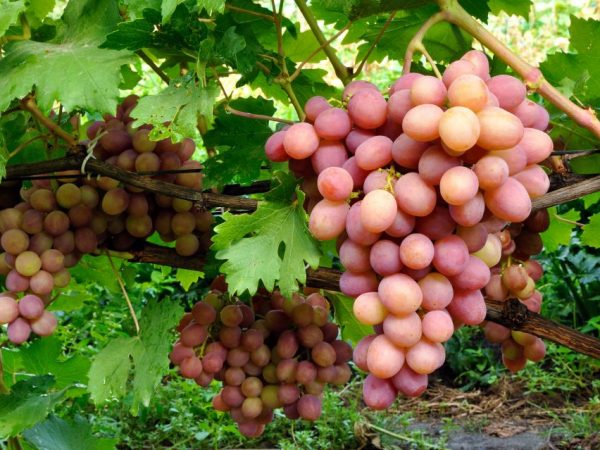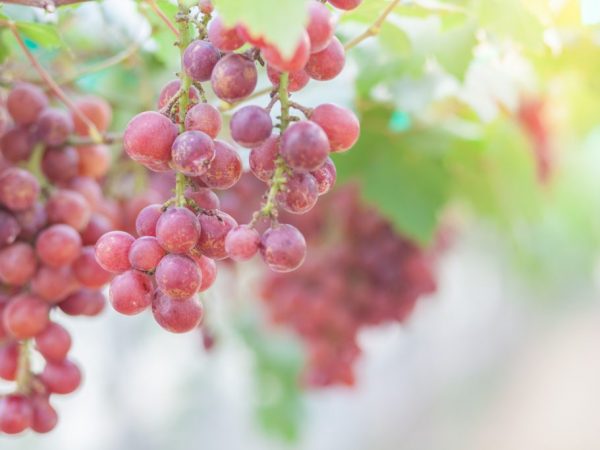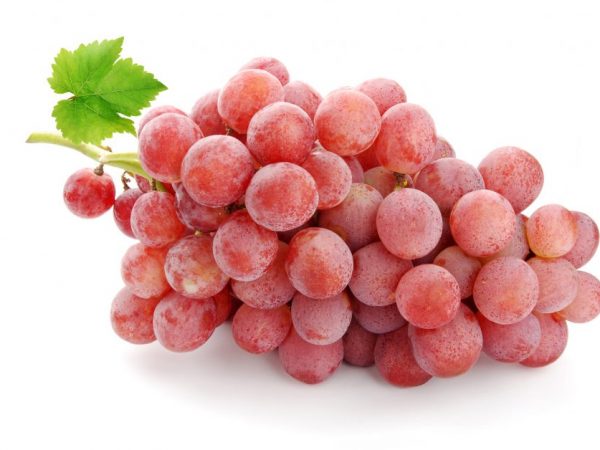Pink grape varieties
Growers use different types of berries for different purposes. Dessert pink grapes, suitable for making wines. Externally exotic berries do not require special care.

Pink grape varieties
Varieties of culture
Pink grape varieties range from light pink to purple hues.
Varieties of varieties:
- Gurzuf variety;
- Dubrovsky;
- Haze;
- Pink kishmish;
- Pearl;
- Chasselas;
- peach;
- Flamingo;
- Minsk;
- Lotus;
- Traminer;
- Pink-amber;
- Dnestrovsky.
These are the main varieties of rose grapes. There are also hybrid forms and late ripening species, but the latter are not suitable for the Russian climate on open ground. They are grown only in greenhouses. It is more difficult and requires special knowledge and skills.
Gurzuf variety
Gurzufsky pink grapes are classified as early ripeness. The ripening period is about 110 days. He was taken out in the city of Gurzuf, on the territory of the Crimea. It is suitable for growing by beginner growers, because it does not require special care.
Description of berries:
- clusters of medium or large size up to 300 g;
- berries are loosely arranged, round in shape;
- have a mild nutmeg taste.
Sugar in berries is about 30%. These are large indicators for the culture, so their calorie content is higher than that of other species. Gurzuf pink loves warmth and light, so it should be grown on the south side of the site, choosing not too moist soil.
Dubrovsky
Of the pink grape varieties, this one has the largest berry size - up to 4 cm in length. Its shape is conical, loosely located on the bunch. The fruit is fleshy, juicy, inside each berry there are 1-2 large seeds.
Dubrovsky is cultivated even in the northern regions of the country, since it has increased frost resistance. Fruiting in the second year after planting. Also, in a temperate climate, varieties were bred: Donskoy and Tambov. Their description is the same as that of the Dubrovsky species.
Pink haze
"Pink Haze" is an early grape variety, you can harvest the fruits in 110-120 days. This type is versatile in use. It is eaten, juice and wine are made. They note good fertility of the berry - up to 6 kg per bush, and a significant size of the bunch - up to 1.5 kg.
Kishmish

The variety does not tolerate frost
The Rose Kishmish grape is an oriental variety derived from wild types of berries. People appreciate it for its lack of seeds.
Pink kishmish - late-ripening grapes, the period of full ripening is 140 days, therefore it is carefully planted in the north.
Despite the late ripening period, significant benefits are noted:
- Vigorous bushes.
- High productivity.
- Resistance to powdery mildew, but a high risk of injury by the grape leafworm.
Pink Kishmish grapes also have disadvantages: it is too thermophilic, requires a lot of light and high temperatures for ripening. Low frost resistance, which does not allow growing it in all regions.
Pearl
This species was obtained by selection, bred by the Russian Institute of Michurinsk.This is a non-sheltering type of culture - it is left to winter without shelter if the air temperature is above -16 ℃. Therefore, pearls are suitable for cultivation in the northern regions, where they are planted from 5 to 30 June.
The description of the view is as follows:
- Sugar content 25%.
- The conical shape of the bunch, weight up to 500 g.
- Delicate pink color of berries.
- High yield - up to 8 kg per bush.
The absence of additional shelter is possible only if there is a protective layer of snow and without temperature fluctuations.
Shasla
This type of berry is used for making wine. Ripening takes place in 130 days in favorable conditions. Bunches in the form of a cone or cylinder, large. The berries are dark pink or deep purple in color.
But for growing in the northern regions, Chasselas is not suitable, because it has a number of features:
- reduced resistance to drought;
- does not tolerate frost;
- susceptible to fungi and infections caused by high humidity.
The species was bred in France, so it is focused on a warm and sunny climate.
Peach look
Little is known about these species, since they cannot determine their origin. It is believed that they were brought out by Krainov. Those who grew the culture give it the following characteristics:
- large bunches - up to 1.5 kg;
- dessert berry;
- the berries have a strawberry flavor.
According to observations, frost resistance reaches -23 ℃. There is a relative resistance to fungal infections.
Flamingo

Berries do not tolerate transportation well
This species was bred abroad. It matures late and requires warm, sunny weather. If the summer is cold, it bears little or does not ripen at all. The berries are pink with a waxy coating. The average weight of a bunch is 700 g, the berries are round.
In cold and rainy summers, the berries can burst.
Because of this, Flamingos are grown primarily in greenhouses privately. It is not used in industry, as it does not tolerate transportation well.
Minsk
This is a Belarusian type of culture obtained by the selection method. A distinctive feature is bunches aligned by weight. The weight of one is about 260 g. It is dense, so the berries are often deformed, which spoils the aesthetic appearance.
Sugar up to 25%. The testers noted the following features of the species:
- High frost resistance (up to -29.6 ℃).
- Resistant to mildew, but prone to gray mold.
- Bushes are often overloaded with crops and need to be rationed.
Low transportability makes this species suitable only for growing at home. The ripening period is very early, therefore it is grown in temperate climates. Minsk is suitable for eating and making wine.
The Ultra Kostrikin species (also of Belarusian origin) is suitable for growing in the north and has similar characteristics.
Pink lotus
The culture of the early ripening period. Like raisins, fruits are seedless, round in shape. Slightly sweet, crispy berries to the taste. Forms large clusters from 800 g to 1.2 kg. Bunches of wide conical shape.
The lotus is resistant to low temperatures.
According to catalogs, it can withstand up to -23 ℃. Not suitable for winemaking, consumed fresh and dried.
Traminer
An old Austrian type of culture, thermophilic and requiring special weather conditions. In the north, it is realistic to grow it only in greenhouse conditions, since the bush recovers for a long time after low temperatures.
It is planted in irrigated areas of chernozem, on the southern and western slopes. The bushes have great vigor. Fruit ripening period is late, up to 155 days. Traminer is prized for making dessert wines, champagne, juice.
Pink-amber
This is an early type of table berry, full ripening occurs after 125 days. The bunches are medium-sized, loose (with a significant distance between the berries). The average weight of a bunch is up to 350 g.
During full maturity, the peel is greenish-amber, in the sun it glows with reddish tints. This is an Altai species, therefore it is successfully grown in temperate climates.
Dniester view
Dniester (or Paradise of the Dnieper) ripens late, about 160 days.They note the good resistance of the Dniester to diseases, increased keeping quality of fruits, early coloring of berries. Resistance to typical diseases simplifies the care of the crop, spraying is done up to 3 times per season.
Average all clusters 250 g. The frost resistance of the species is relative, it is cultivated mainly in the south. For a temperate climate, the species is proposed to be grown in greenhouse conditions.
Conclusion
Pink grapes are represented by many varieties that have different characteristics, origins and purposes. Most of them are suitable for growing in temperate climates, if not for open ground, then for greenhouse conditions.
The benefit of the berry is that it is universal: suitable for raw consumption, winemaking, juices and raisins.


